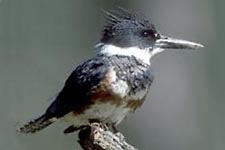Local Wildlife
Belted Kingfisher

Audio: Listen Now
Scientific Name: Ceryle alcyon
Audio Source: Unknown
More Info: Univ. of Michigan
The belted kingfisher has a stocky body with a head and bill that are disproportionately large. They are blue-gray in color with a white collar and belly, a gray chest band, and a ragged, double-pointed crest. Unlike most other birds, it is the female that has the conspicuous coloring of an additional rufous-colored chest band.
Belted kingfishers eat various types of fish (particularly trout, sculpin, and salmon). Although most fish are small, they have been known to swallow fish as long as themselves. If fish are scarce, they may eat mollusks, crustaceans, insects, amphibians, reptiles, young birds, small mammals, and berries.
The kingfisher generally hunts from perches near streams or other bodies of water. As a result, your best opportunity for seeing them is to take one of the paths that wind along the Deschutes river and watch for them "fishing" along the shallows of the river. The birds dive for prey, grabbing it near the surface of shallow waters. Once it has captured its meal, it returns to a branch, stuns its prey, tosses it into the air, catches it headfirst, swallowing it.
After mating, a kingfisher pair will dig a tunnel into a wall of clay or sand with a nesting cavity at the end. The pair generally prefer to construct the burrow near their fishing territory. A clutch is usually six to eight eggs. Pairs strongly defend their territories throughout the breeding season with most territorial defense accomplished through "scolding" and aerial chases.
